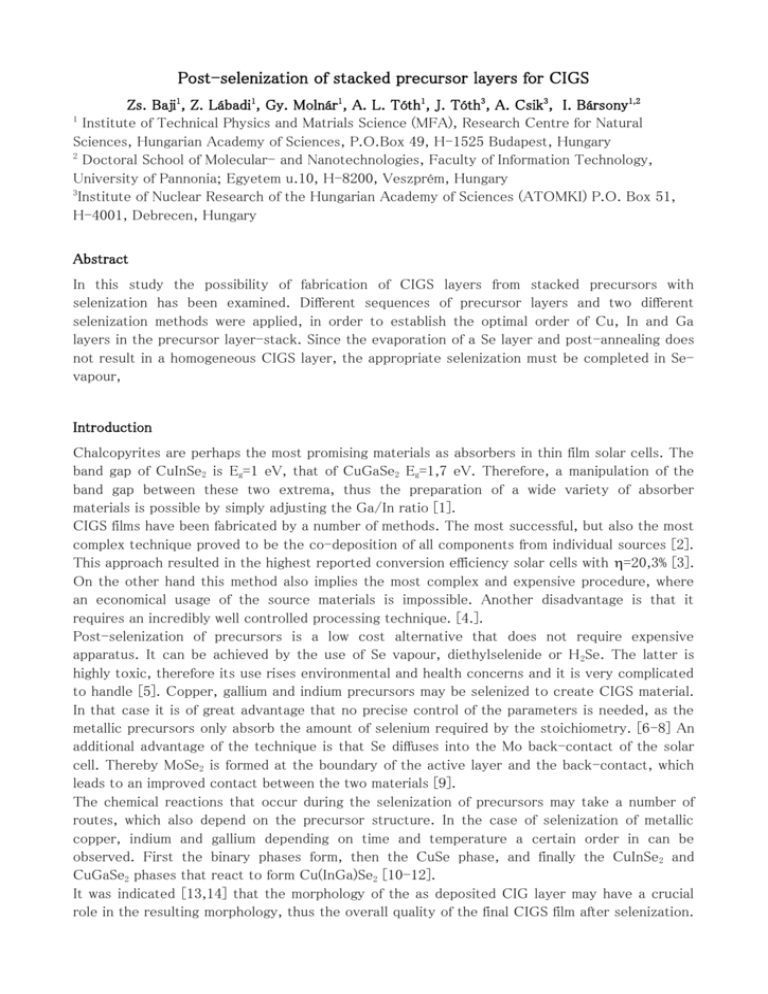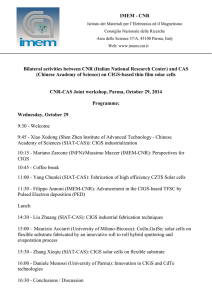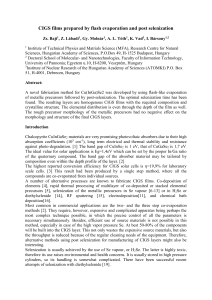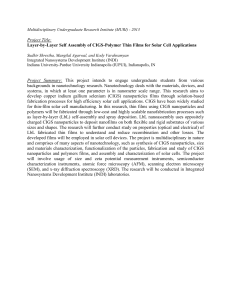doc - MTA MFA
advertisement

Post-selenization of stacked precursor layers for CIGS Zs. Baji1, Z. Lábadi1, Gy. Molnár1, A. L. Tóth1, J. Tóth3, A. Csik3, I. Bársony1,2 1 Institute of Technical Physics and Matrials Science (MFA), Research Centre for Natural Sciences, Hungarian Academy of Sciences, P.O.Box 49, H-1525 Budapest, Hungary 2 Doctoral School of Molecular- and Nanotechnologies, Faculty of Information Technology, University of Pannonia; Egyetem u.10, H-8200, Veszprém, Hungary 3 Institute of Nuclear Research of the Hungarian Academy of Sciences (ATOMKI) P.O. Box 51, H-4001, Debrecen, Hungary Abstract In this study the possibility of fabrication of CIGS layers from stacked precursors with selenization has been examined. Different sequences of precursor layers and two different selenization methods were applied, in order to establish the optimal order of Cu, In and Ga layers in the precursor layer-stack. Since the evaporation of a Se layer and post-annealing does not result in a homogeneous CIGS layer, the appropriate selenization must be completed in Sevapour, Introduction Chalcopyrites are perhaps the most promising materials as absorbers in thin film solar cells. The band gap of CuInSe2 is Eg=1 eV, that of CuGaSe2 Eg=1,7 eV. Therefore, a manipulation of the band gap between these two extrema, thus the preparation of a wide variety of absorber materials is possible by simply adjusting the Ga/In ratio [1]. CIGS films have been fabricated by a number of methods. The most successful, but also the most complex technique proved to be the co-deposition of all components from individual sources [2]. This approach resulted in the highest reported conversion efficiency solar cells with =20,3% [3]. On the other hand this method also implies the most complex and expensive procedure, where an economical usage of the source materials is impossible. Another disadvantage is that it requires an incredibly well controlled processing technique. [4.]. Post-selenization of precursors is a low cost alternative that does not require expensive apparatus. It can be achieved by the use of Se vapour, diethylselenide or H 2Se. The latter is highly toxic, therefore its use rises environmental and health concerns and it is very complicated to handle [5]. Copper, gallium and indium precursors may be selenized to create CIGS material. In that case it is of great advantage that no precise control of the parameters is needed, as the metallic precursors only absorb the amount of selenium required by the stoichiometry. [6-8] An additional advantage of the technique is that Se diffuses into the Mo back-contact of the solar cell. Thereby MoSe2 is formed at the boundary of the active layer and the back-contact, which leads to an improved contact between the two materials [9]. The chemical reactions that occur during the selenization of precursors may take a number of routes, which also depend on the precursor structure. In the case of selenization of metallic copper, indium and gallium depending on time and temperature a certain order in can be observed. First the binary phases form, then the CuSe phase, and finally the CuInSe2 and CuGaSe2 phases that react to form Cu(InGa)Se2 [10-12]. It was indicated [13,14] that the morphology of the as deposited CIG layer may have a crucial role in the resulting morphology, thus the overall quality of the final CIGS film after selenization. Both evaporated and sputtered CIG layers are inhomogeneous with a rough surface, which would deteriorate the quality of the resulting films. Another often mentioned disadvantage is that gallium tends to diffuse near the back contact at the high temperatures during selenization, while the top layers become richer in indium. This finally results in an adverse phase separation of CIS and CIGS material, which reduces the device efficiency. Motivation In our previous studies [15] we examined flash evaporated and post-selenized layers and found that even a rough morphology of precursor metals results in homogeneous CIGS layers after selenization. On the other hand these layers showed low mechanical stability and adhesion to the substrate underneath. The aim of the present work is to analyse whether sequentially evaporated precursors could also result in homogeneous layers with perhaps improved mechanical properties. Another disadvantage of the flash evaporation method [15] was that the thickness of the deposited precursor material was <400 nm due to the limited size of the evaporation source, which resulted in ca. 800nm of CIGS material. In the present work we attempted to determine how thick precursor layers could be selenized reliably and what the optimal selenization method is. Experimental: CIGS layers were deposited by selenization of metallic precursors. To examine the effect of the order of the layers in the stack we deposited them in all possible deposition sequences. Si and glass substrates were used, both cleaned in cleaned in cc.HNO3 and high purity water before layer deposition. The sputtering and evaporation took place in a flexible research tool optimized for the manufacturing of a Cu(InGa)Se2 based solar cell module. Mechanical movement, gas pressure and composition, DC electric supply and additional pulse parameters are monitored and controlled by computer. Mo layers were deposited and target characteristics monitored by pulsed DC magnetron sputtering (10 µs period length with 10% duty factor) from a metallic Mo target. The size of this target is 114x440 mm2. Under the target at a working distance of 60 mm the target was moved at a speed of 50 mm/s bidirectionally. The electric supply unit can work both in DC and adjustable pulse mode. Before opening the Ar valves the pressure in the vacuum chamber was typically 8·10-7 mbar. Depositions and target characterization were made typically at 6·10-3 mbar working pressure (measured by Edwards WRG – S type Gauge) with a total gas inlet of 50 sccm. The target power in power controlled mode was 750W and the target voltage was 300-315V. We applied no substrate bias and no pre-heating. Cu layers were deposited from a Cu target in the same magnetron sputtering tool under the same conditions. The target power was 250 W, the target voltage was 290 V. The sputter deposition chamber (manufactured by Energosolar, Hungary) forms an integral part of a complex vacuum system containing also loadlock, laser structuring and evaporation chambers, where the In and Ga layers were evaporated. The temperature during In evaporation was T=1040-1060°C and the pressure p=2·10-5 mbar, In the case of the Ga evaporation T=1115-1141°C and p=1,7·10-5mbar. Table 1 summarizes the prepared samples. 1 Mo In Ga Cu Selenization with Se evaporation and annealing 2 Mo Ga In Cu Selenization with Se evaporation and annealing 3 Mo Cu In Ga Selenization with Se evaporation and annealing 4 Mo Cu Ga In Selenization with Se evaporation and annealing 5 Mo In Ga Cu Selenization with Se vapour 6 Mo Ga In Cu Selenization with Se vapour 7 Mo Cu In Ga Selenization with Se vapour 8 Mo Cu Ga In Selenization with Se vapour Table 1. Summary of sample parameters Two different approaches were applied for selenization of the consecutively deposited precursors. The first consisted of evaporation of selenium on top of the layer stack and an additional annealing so that the Se could diffuse into the layers, and the precursors transform into CIGS layer. This process took place in a vacuum chamber designed for this purpose. The background pressure was p~10-6 mbar. The Se source was a resistivity heated W-boat. The estimated temperature of the source was T=800°C. Se pellets were used which completely evaporated during the ramp-up and hold period (one minute each) at the final boat temperature. Thereby the thickness of the “selenium source layer” on the differently stacked precursors is expected to be constant. The substrate temperature was T=430°C during evaporation, followed by a 20 min annealing step at the same temperature. The other method was the annealing of the precursors in Se atmosphere for 15 minutes at T=500oC. The XRD measurements were performed with Cu K radiation using a Bruker AXS D8 Discover horizontal X-ray diffractometer equipped with Göbel mirror and a two dimensional GADDS detector system. The beam diameter was about 500 m. The scanning electron microscopy measurements were carried out in a LEO 1540 XB microscope equipped with a Schottky field emission gun, Gemini lens system and in-lens detector. Results and discussion 1. Precursor morphology after evaporation Fig. 1. shows the SEM micrographs (left) and the Electron Dispersive Spectra (EDS- maps) (right) of the precursors. It is evident on almost all samples that the precursors completely covered the substrates. The average grain size of the samples is 100-200 nm. The importance of the deposition order of the precursor metals is revealed by the comparison of the micrographs. The first row in Fig. 1. shows the morphology of sample 1. The surface is scattered with 0,5-1 μm sized islands. On a larger scale (see the elemental map beside), 10μm sized islands can be found on the surface. From the component analysis the smaller objects appear to be In-grains, whereas the larger ones Ga-droplets. By looking at the origin of this morphology we have to consider that In, when evaporated, forms droplets on the substrate surface. In case of this sample the Ga was evaporated afterwards on this surface, and finally the Cu was sputtered. During sputtering the substrate temperature exceeded the melting point of Ga, which then diffused to the top of the layers. Thus, although the Cu sputtering took place after the Ga evaporation, the gallium droplets can be found on top of the evenly sputtered copper layer. This applies to the cases where the evaporations were followed by the sputtering. This effect may be even of advantage, as a higher Ga content in the top layer of the film results in an ideal band gap profile with a wider band gap at the active region and a Ga rich layer near the surface. The SEM results of sample 2 can be seen in the 2nd row of Fig. 1. Once again the Ga droplets are apparent, but no In islands could be found according to the larger scale image. The morphology of sample 3. is presented in the 3rd row. In this case the In layer was evaporated on top of the sputtered copper layer. This time the Ga was evaporated last, therefore the morphology is slightly different, the Ga-islands are smaller. The only sample where no Ga droplets could be found is sample 4. (4 th row) The sole inhomogeneities in this layer are the In grains of μm size. The elemental distribution of the sample reveals large regions of In-deficiency. Fig. 1. SEM micrographs (left) at 5000x magnification in (a) and 50000x magnification (c,e,g) and element maps (right) of the evaporated precursors for sample 1, 2, 3 and 4 in the respective rows. 2. Post-annealing of stacked precursors The SNMS results of the layers can be seen in the first column of Fig. 2. The results must be interpreted with some caution though, as due to the rough surface morphology of the layers the intensities from - at least the surface layers - may be somewhat misleading. This is also the reason why no depth scale can be calculated from these results. In all cases the increase of the Mo-yield indicates the bottom of the precursor layer. From the depth profiles the following observations can be made: The layers of the precursor metals are still visible, in the original order of the deposition. Therefore, the metals did not mix with each other and the alloy formation was negligible at the temperature of the selenization. On the other hand, as the Se diffused into the layer, a mixing of the components started, which can be seen from the way the In layer always diffuses towards the surface. The In concentration rapidly increases in the Se-containing top layer. Therefore, the local minima in the In depth profile indicate chemical reactions. Fig. 2. SNMS Depth profiles (left) and corresponding SEM cross sections (right) of the samples selenized with Se evaporation: Samples 1, 2, 3 and 4 in the respective rows. Comparing these results with the cross sectional SEM images in the right column of Fig. 2, the thickness of the selenized CIGS layers and that of the unreacted precursor film, which remained underneath, may be defined. For sample 1 this means 1,4-1,7 μm thick CIGS on top of 500-550 nm thick metal. In sample 2: 1-1,3 μm CIGS on 550-600 nm metallic layer. Sample 3 is the most uneven layer, with 1 μm high CIGS islands on ~500 nm thick CIGS layer. There is also ca. 300 nm thick metallic layer visible underneath. Sample 4: ~1 μm thick CIGS on ~400 nm precursor layer. It is evident that the selenization was more effective in the samples where the Cu was at the bottom. Samples 3 and 4 have a much rougher morphology, with more unreacted precursors remaining at the bottom. Fig 3. The XRD results are shown in Fig 3., and the main characteristics of the layers are summarized in table 2. 1 CuIn0,7Ga0.3Se2 and CuInSe2 phases with metallic In 2 CuInSe2 phase dominates, with some CuIn0,7Ga0.3Se2 , and some metallic In 3 CuInSe2 phase with (213) orientation apparent, but with small grains, and some Cu and In. 4 CuInSe2 phase with In and Cu Table 2. Phases identified by XRD in the samples 1-4 In conclusion, besides the phases CIGS and CIS selenides were formed and a portion of the metallic precursors remained unreacted at the bottom of the layer stack as evidenced by the SEM micrograph shown in Fig 2. This can probably be ascribed to the Se-deficiency, i.e. to the insufficient Se evaporated on the layers. Moreover, a portion of this Se probably even evaporates from the layer stack at the annealing temperature instead of diffusing into it. 3. Selenization of precursors in Se vapour Fig. 4. Typical SEM morphology of samples 5 and 6 (a)at a 2000x magnification, and of samples 7 and 8 (b) at 20 000x magnification. The composition of the layers according to the EDS analysis is shown in table 3. Sample no./component Cu In Ga Se 1 35,7% 15,5% 5,1% 43,7% 2 35,5% 15,7% 2,6% 46,1% 5 26,9% 17,8% 6,6% 48,8% 8 16,5% 29,5% 2,5% 51,5% Ideal composition 25% 17,5-20% 5-7,5% 50% Table 3. EDS elemental composition of samples 5-8 along with the stoichiometric composition. Fig. 4. shows SEM micrographs of the samples after the selenization. All the samples became laterally uniform in composition. Samples 5 and 6 have a generally similar morphology (see Fig. 3a), the circular („cauliflower-like”) grains usually observed on CIGS films cannot be found here. This could result in a denser, more uniform surface, which is generally considered more appropriate for a probably better efficiency. Samples 7 and 8 have a similar morphology, except for the hexagonal crystallites scattered all over the surface. Fig. 5. shows the SNMS results and the cross sectional SEM images of the samples. All the layers are built up from two sublayers of different morphologies: a bottom layer with a finer structure, and a top layer with larger grain size. In the films where the Cu was sputtered first (see sample 7 and 8 in 3rd and 4th row of Fig. 4.) this difference is even more prominent. On the other hand the SNMS depth profiles (left column in Fig. 4.) show that the Se diffused throughout the full depth of all the layers, although the depth profiles are not homogeneous. For an understanding of the background of this phenomenon, the XRD results need to be analysed. 90 C O Si Cu Ga Se Mo In 80 Concentration [at %] 70 60 50 40 30 20 10 0 0 200 400 600 800 1000 1200 1400 1600 Depth [nm] 100 90 C Si Cu Ga Se Mo In Concentration [at %] 80 70 60 50 40 30 20 10 0 0 500 1000 1500 2000 Depth [nm] 100 C Si Cu Ga Se Mo In 90 Concentration [at %] 80 70 60 50 40 30 20 10 0 0 200 400 600 800 1000 1200 1400 1600 Depth [nm] 100 C O Si Cu Ga Se Mo In 90 Concentration [at %] 80 70 60 50 40 30 20 10 0 0 500 1000 1500 2000 Depth [nm] Fig. 5. SNMS depth profiles (left) and corresponding SEM cross sections (right) of the samples selenized in Se vapour: samples 5, 6, 7 and 8 shown in the rows 1-4, respectively. The XRD spectra (in Fig. 6.) revealed that all the layers contained chalcopyrite phase, some also had one of the metallic precursors in excess. A summary of the crystalline quality of the layers is given in table 4. Fig. 6. XRD spectra of the CIGS layers. (samples 5,6,7 and 8) 5 Predominantly CuIn0,7Ga0.3Se2 with a little CuInSe2 phase present. 6 Both CuInSe2 and CuIn0,7Ga0.3Se2 phases present, the CuInSe2 phase is more dominant. 7 Only one chalcopyrite phase present, that of CuIn0,9Ga0.1Se2 with some hexagonal CuSe. 8 CuInSe2 and CuIn0,7Ga0.3Se2 phases with a little hexagonal CuSe present. Table 4. Phases in the samples 5-8 identified by XRD. The absence of binary phases and the CuInGaSe2 phase in case of the samples 5 and 6 indicates that the selenization reaction was complete. The two different layers apparent in the cross sectional images may be the CIS and the CIGS phases, therefore a phase separation must have taken place with the CIS at the top and the CIGS dominantly at the bottom of the layer stack. In samples 7 and 8, however, CuSe is still present. The hexagonal phase CuSe forms probably the crystallites occurring in the SEM micrographs in Fig. 3b. Since in these samples the copper was sputtered first, i.e. Cu was the bottom layer in the layer structure, which is probably why some CuSe was left in the samples. Therefore, this layer structure is either less favourable, or it requires a longer annealing time. Sample 8 also reflected a separation of the phases CIGS and CIS. It is obvious from the XRD results that where Ga is lying deeper in the layer stack than In, the phase separation is more pronounced. Summary of the XPS analysis of the samples XPS binding energies were evaluated and summarized in Table 5. evaluated using the NIST XPS binding energy database. Binding energies were Se 3d In 4d 5/2 Cu 2p 3/2 54,4 eV 444,5 eV 932,5 eV Reference foreign 54,45 eV CIGS sample (own measurement) 444,6 eV - Reference CuInSe2 444.6-444.8 eV 932.1-932.6 eV Sample 8 [16.] 54.3-54.5 eV Cu metal (own measurements) 932,35 eV In metal Se 443,9 eV 55,2 eV Table 5. XPS Binding energies of Se, In and Cu measured on sample 8 and on reference samples The accuracy of our own measurement is in the range of +- 0.1 eV (similar to the accuracy of [16]). The XPS binding energies are in good agreement with the XRD data and show the presence of CuInSe2 and CuIn0,7Ga0.3Se2 phases in sample 8. In conclusion, by this selenization method more homogeneous depth profiles and CIGS layer formation could be registered. Conclusions Two different post-selenization methods were compared on the consecutively evaporated components of the quaternary CIGS structure. We found that the evaporation of Se and subsequent annealing is not sufficient for all the reactions needed to result in a homogeneous CIGS layer. Therefore, the proper selenization must be performed by an annealing in Se-vapour. Layers with Cu on top provide better CIGS compositions with both selenization methods. The reason for that is probably that both In and Ga diffuse faster in a Cu rich environment [10]. It is interesting to note, that with In atop of Ga more CIS is present. On the other hand the CGS phase was never foundidentified in the layers, not even with Ga on top. This is explained in all cases by the diffusion of In towards the Se rich surface, resulting in a more homogeneous precursor structure. We determined the optimum sequence in the deposition of the precursor metals. Cu sputtering as top layer is most favourable for subsequent selenisation, as it ensures to some extent a mixing of the layers. During sputtering of Cu namely Ga-outdiffusion can take place. On the other hand In has to be covered by Ga in the layer stack, therefore the optimal sequence is: In, Ga, Cu followed by post-selenization in Se vapour. Acknowledgement The help of Dr. Zs.E. Horváth of MFA with XRD and Dr. K. Vad of MTA ATOMKI with SNMS is gratefully acknowledged. The authors with to thank the Hungarian National Science Fund OTKA Grant No. NK73424 for the support. This work was also supported by the National Development Agency grant TÁMOP-4.2.2/B-10/1-2010-0025. References 1. R. Klenk, M. C. Lux-Steiner, Chalcopyrite Based Solar Cells, in J. Poortmans, V. Arkhipov (Eds) Thin Film Solar Cells, Wiley, 2006 2. M. Powallaa, B. Dimmler, Development of large-area CIGS modules, Sol. Energy Mater. Sol. Cells 75 (2003) 27–34 3. P. Jackson, D. Hariskos, E. Lotter, S. Paetel, R. Wuerz, R. Menner, W. Wischmann and M. Powalla, New world record efficiency for CIGS thin film solar cells beyond 20%, Prog. Photovolt: Res. Appl. 2011; 19:894–897 4. M. Klenk, O. Schenker, V. Alberts, E. Bucher, Preparation of device quality chalcopyrite thin films by thermal evaporation of compound materials, Semic. Sci. And Technol. 17 (2002)435-439 5. W. Li, Y. Sun, W. Liu, L. Zhou, Fabrication of Cu(InGa)Se2 thin films solar cell by selenization process with Se vapor, Sol. Energ. 80 (2006) 191-195 6. M. Ganchev, J. Kois, M. Kaelin, S. Bereznev, E. Tzvetkova, O. Volobujeva, N. Stratieva, A. Tiwari, Preparation of Cu(In,Ga)Se2 layers by selenization of electrodeposited Cu-In-Ga precursors, Thin Solid Films 511-512 (2006) 325-327. 7. R. Caballero, C. Maffiotte, C. Guillén, Preparation and characterization fo CuIn1-xGaxSe2 thin films obtained by sequential evaporations and different selenization processes, Thin Solid Films 474 (2005) 70-76. 8. G. S. Chen, J.C. Yang, Y.C. Chan, L.C. Yang, W. Huang, Another route to fabricate single-phase chalcogenides by post-selenization of Cu-In-Ga precursors sputter deposited from a single ternary target, Sol. Energy Mater. Sol. Cells 93 (2009) 1351-1355. 9. D. Abou-Rasa,b,*, G. Kostorza, D. Bremaudb, M. K7linb, F.V. Kurdesaub, A.N. Tiwari, M. Dfbeli, Formation and characterisation of MoSe2 for Cu(In,Ga)Se2 based solar cells, Thin Solid Films, 480–481 (2005) 433– 438 10. O. Lundberg, J. Lu, A. Rockett, M. Edoff, L. Stolt, Journal of Physics and Chemistry of Solids 64 (2003) 1499 11. W. K. Kim, E. A. Payzant, S. Kim, S. A. Speakman, O. D. Crisalle, T. J. Anderson, J. Cryst. Growth, 310 (2008), 2987. 12. W. K. Kim, E. A. Payzant, T. J. Anderson, O. D. Crisalle, Thin Solid Films, 215 (2007) 5837. 13. C.-Y. Su, W.-H. Ho, H.-C. Lin, C.-Y. Nieh, S.-C. Liang, The effects of the morphology on the CIGS thin films prepared by CuInGa single precursor, Sol. Energy Mater. Sol. Cells, 95 (2011) 261-263 14. W. Liu, J.-G. Tian, Q. He, F.-Y. Li, Y. Sun, Effect of metallic precursors on the thin film thickness and reaction resistances in the selenization process, Curr. Appl. Phys, (2010) doi:10,1016/j.cap.2010,07,028 15. Zs.Baji, Z. Lábadi, CIGS films prepared by flash evaporation and post selenization, Thin Solid Films, submitted 16. S. Kohiki, M. Nishitani, T. Negami, T. Wada, X-ray photoelectron spectroscopy of CuInSe2, Phys. Rev. B45 p. 9163, 1992







